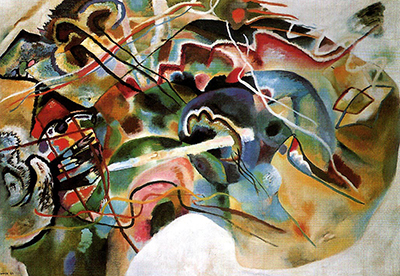It was May, 1913 that marked the arrival of this complex artwork from Wassily Kandinsky, which he titled Bild mit weißem Rand, or Painting with White Border.
The artist took a large canvas, over two metres wide, and filled it top to bottom with all manner of different shapes and colours. It is typical of his work at this time, as he developed onwards from his earlier abstract landscape scenes of a few years earlier. Whilst we include images of the painting here, it can only really be understood and appreciated by viewing it in person, due to its size and complexity - head to the Guggenheim in order to do so. This Russian artist would make his biggest impact in Germany, but never lost the influence of his native land on his work. In this painting he is attempting to recreate the character of Russia after a recent return to Moscow for a short break. Painting with White Border was actually the culmination of many study drawings and paintings which prepared his mind for this completed piece, and so everything is far more planned than you might initially expect.
The choice of the white border in this piece is important. It is mentioned in the title too, and this is because he held a symbolic importance to this colour. He once described how it communicates a silence, and carries a wealth of opportunities. The border itself sweeps around the right hand side in a circular shape, providing a clear contrast with the rest of the busy composition which is lively in colour and detail. He uses shades of colour much more here than in recent years, where blocks of single colours were used instead. This makes the whole design merge together into an organic creation much better, where as before it would be a combination of colour more akin to a patchwork, with each area remaining fairly independent.
Head to the Guggenheim to see this artwork in person. They own a number of other artworks from his career which are likely to have been acquired at the same time. You will find Cubist art particularly well represented, with the likes of Fernand Léger, Jean Metzinger, Juan Gris and Georges Braque here as well as a number of paintings from one of the biggest influences upon them, namely Paul Cezanne. It ranks as one of the finest collections in the US, though there are now satellite versions of the museum in other countries, which allows the large collection to be rotated around and shown to more members of the public.




